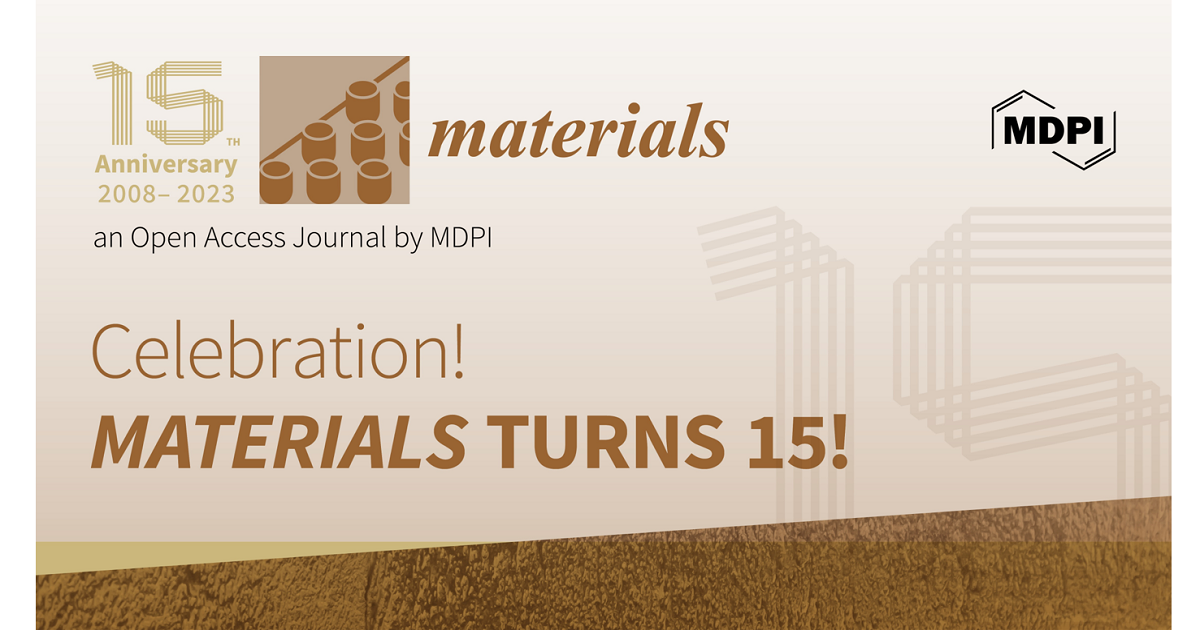- 3.2Impact Factor
- 6.4CiteScore
- 16 daysTime to First Decision
The 15th Anniversary of Materials—Recent Advances in Advanced Materials Characterization
This special issue belongs to the section “Advanced Materials Characterization“.
Special Issue Information
Dear Colleagues,
This special issue focuses on the advancement in the characterization of materials. The recent development of materials has made their structures and properties sophisticated. This situation requires us to modify existing techniques to characterize material properties accurately. A well-established method conventionally used for materials at the macroscopic scale may be inapplicable to the same material at the nanoscopic scale. Conventional characterization methods developed for metals may be inappropriate for biological specimens. On some occasions, a completely new characterization technique is necessary. At the same time, a combination of traditional methods may be sufficient. Analytical methods are also critical. Efficient extraction of signals buried in noise may make a conventional characterization technique effective. This special issue welcomes papers that discuss these problems in various science and engineering fields. Interdisciplinary studies are of particular interest.
Submissions should be in the form of original research articles or authoritative review papers. The topics of interest include but are not limited to the following areas:
- Multiscale and hybrid methods for material characterization;
- Inverse methods for material characterization;
- Conventional and Super-resolution microscopy for material characterization;
- Optical methods (including image correlation) for material characterization;
- Mechanical characterization (static and dynamic);
- Acoustic methods (including acoustic microscopy) and characterization;
- Thermophysical methods and characterization;
- Electromagnetic methods and characterization;
- Characterization of biomedical materials;
- Surface characterization;
- Machine learning and AI (Artificial Intelligence) for data extraction/analysis and pattern processing.
Prof. Dr. Sanichiro Yoshida
Prof. Dr. Luciano Lamberti
Prof. Dr. Giuseppe Lacidogna
Guest Editors
Manuscript Submission Information
Manuscripts should be submitted online at www.mdpi.com by registering and logging in to this website. Once you are registered, click here to go to the submission form. Manuscripts can be submitted until the deadline. All submissions that pass pre-check are peer-reviewed. Accepted papers will be published continuously in the journal (as soon as accepted) and will be listed together on the special issue website. Research articles, review articles as well as short communications are invited. For planned papers, a title and short abstract (about 250 words) can be sent to the Editorial Office for assessment.
Submitted manuscripts should not have been published previously, nor be under consideration for publication elsewhere (except conference proceedings papers). All manuscripts are thoroughly refereed through a single-blind peer-review process. A guide for authors and other relevant information for submission of manuscripts is available on the Instructions for Authors page. Materials is an international peer-reviewed open access semimonthly journal published by MDPI.
Please visit the Instructions for Authors page before submitting a manuscript. The Article Processing Charge (APC) for publication in this open access journal is 2600 CHF (Swiss Francs). Submitted papers should be well formatted and use good English. Authors may use MDPI's English editing service prior to publication or during author revisions.
Keywords
- biomedical materials
- material characterization with multiple methods
- machine learning algorithms for data analysis
- optical methods
- acoustic methods
- electromagnetic methods
- novel probing techniques

Benefits of Publishing in a Special Issue
- Ease of navigation: Grouping papers by topic helps scholars navigate broad scope journals more efficiently.
- Greater discoverability: Special Issues support the reach and impact of scientific research. Articles in Special Issues are more discoverable and cited more frequently.
- Expansion of research network: Special Issues facilitate connections among authors, fostering scientific collaborations.
- External promotion: Articles in Special Issues are often promoted through the journal's social media, increasing their visibility.
- e-Book format: Special Issues with more than 10 articles can be published as dedicated e-books, ensuring wide and rapid dissemination.

